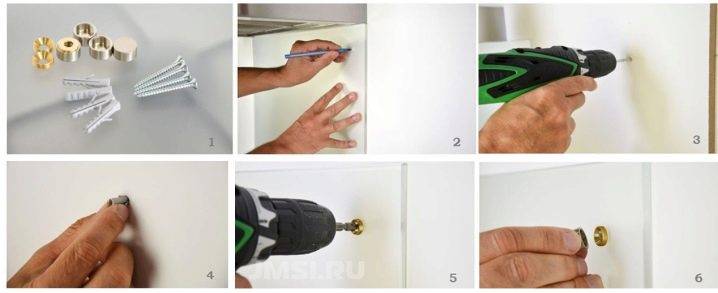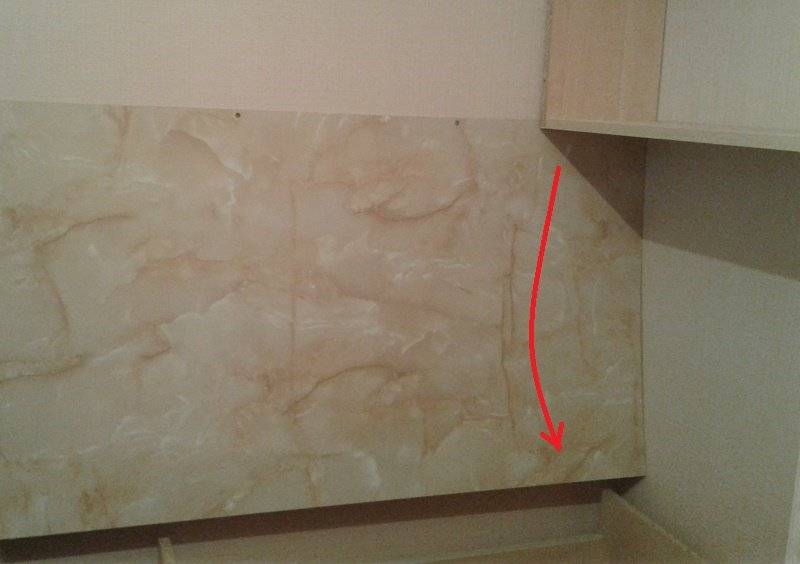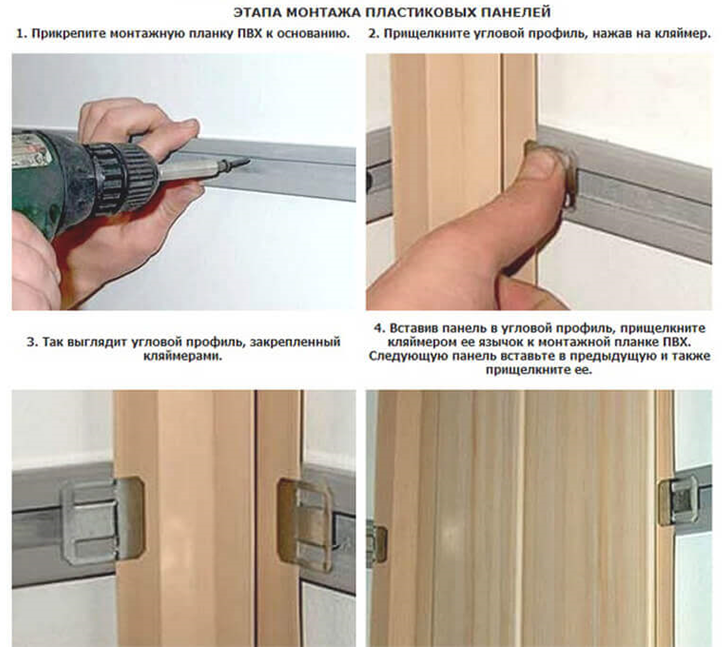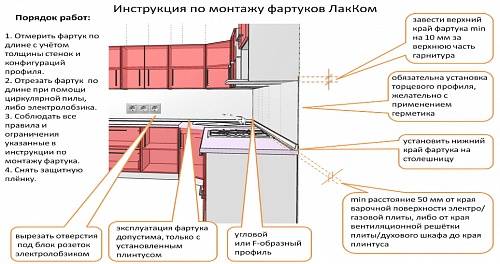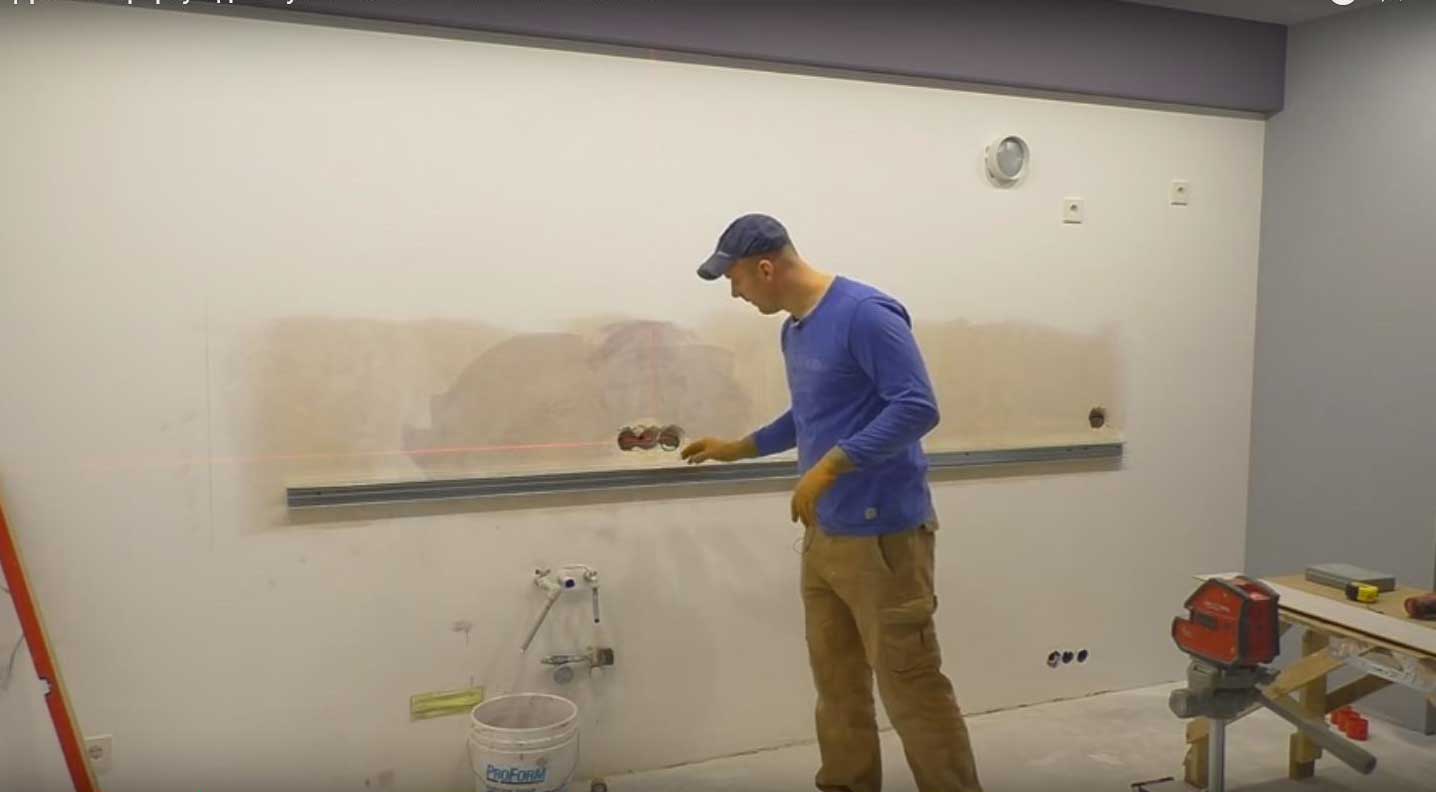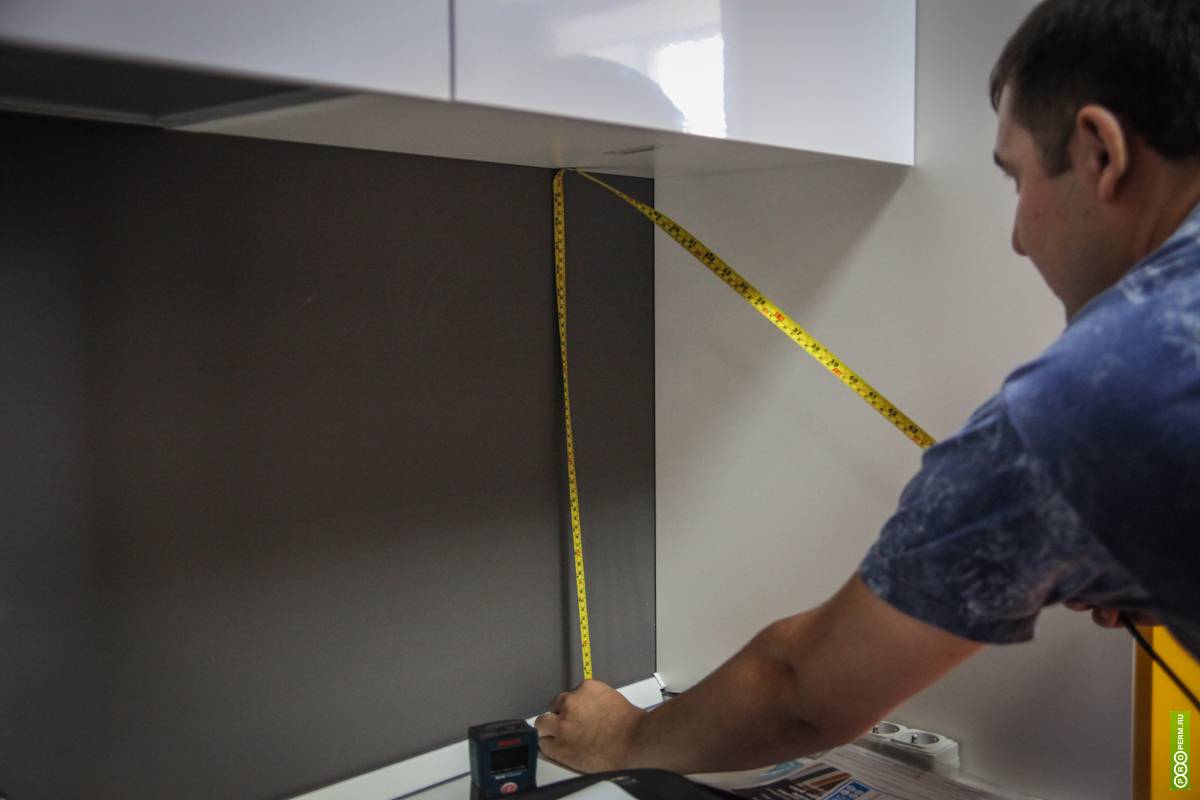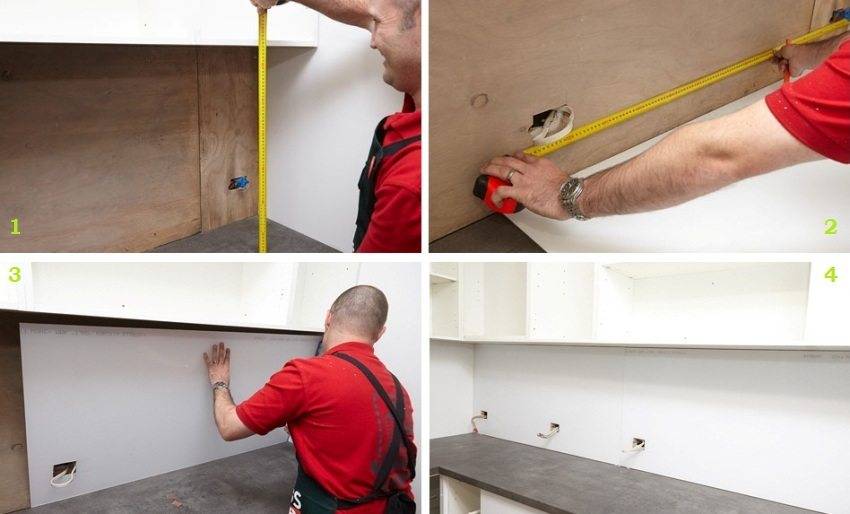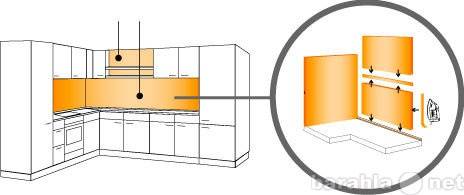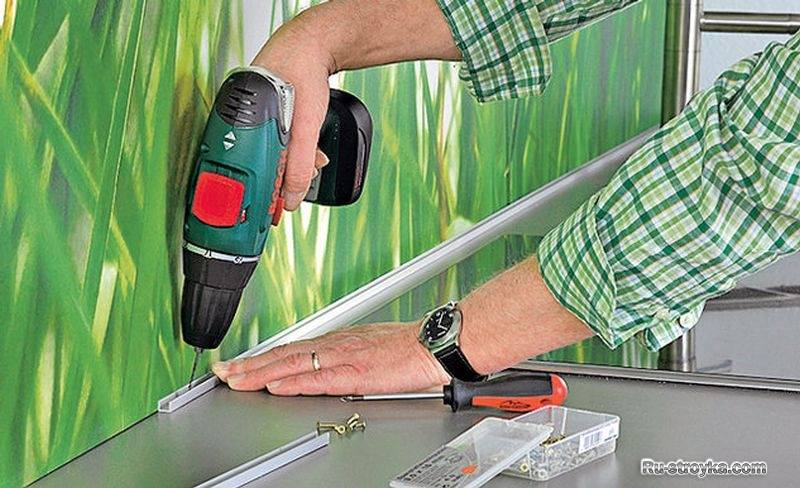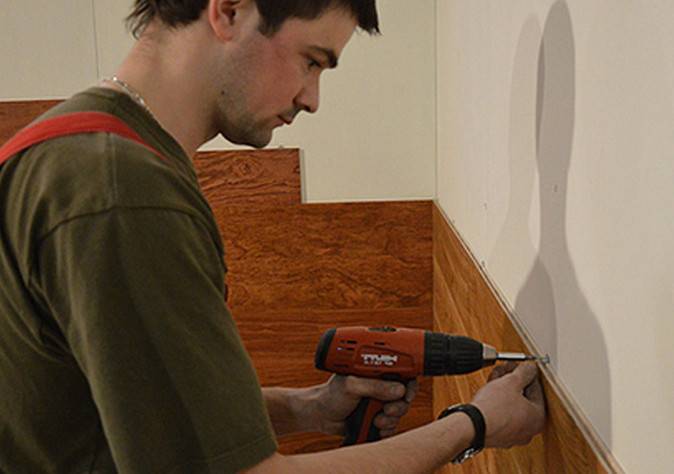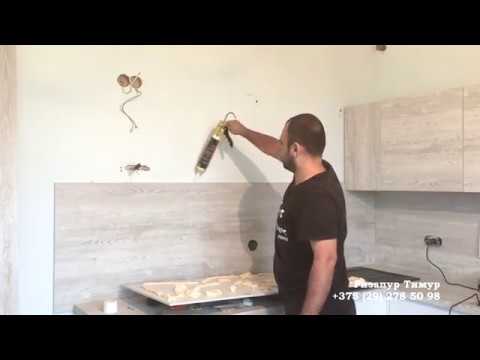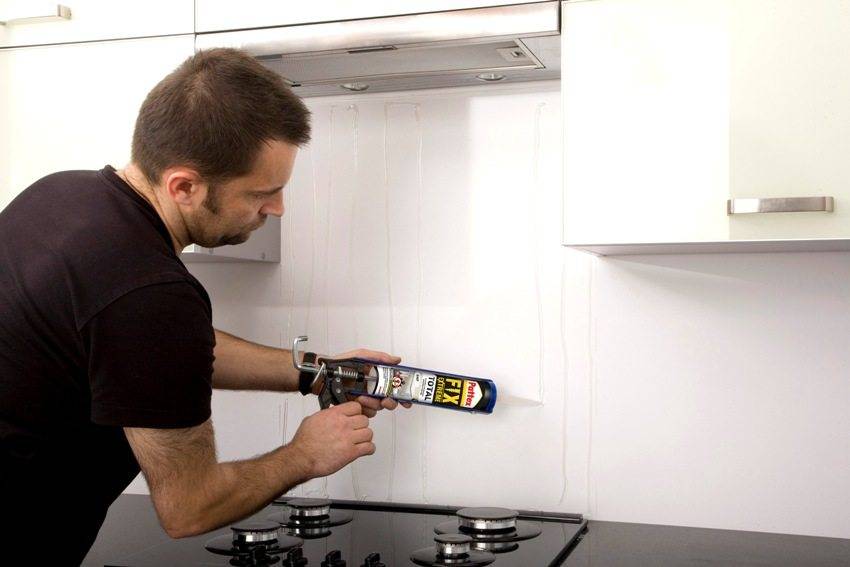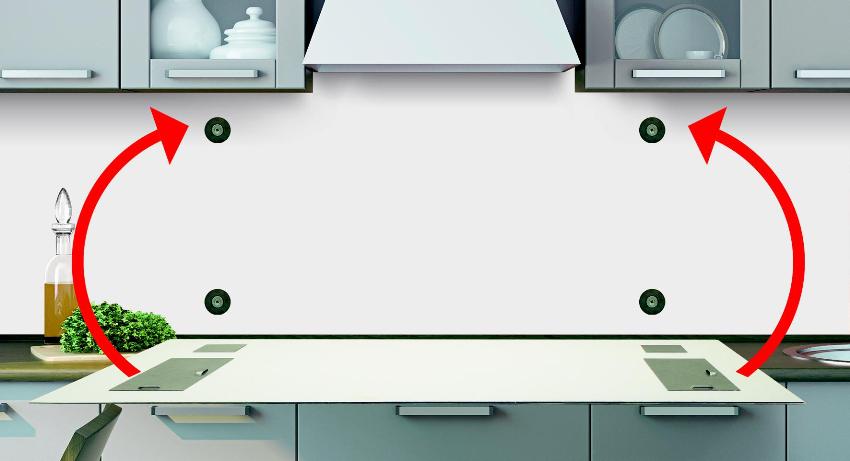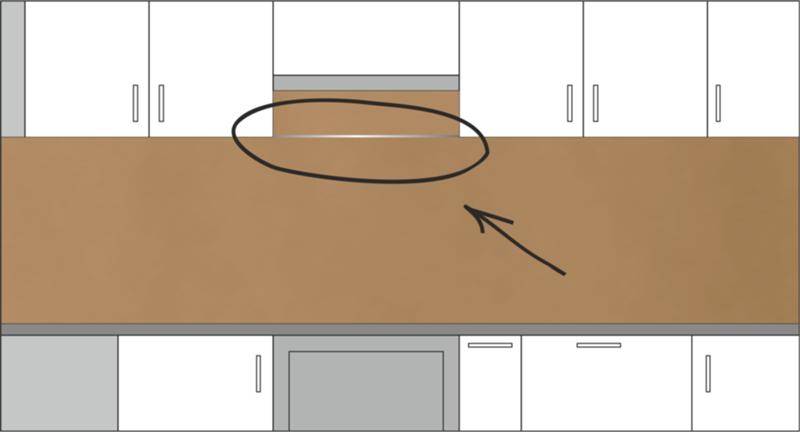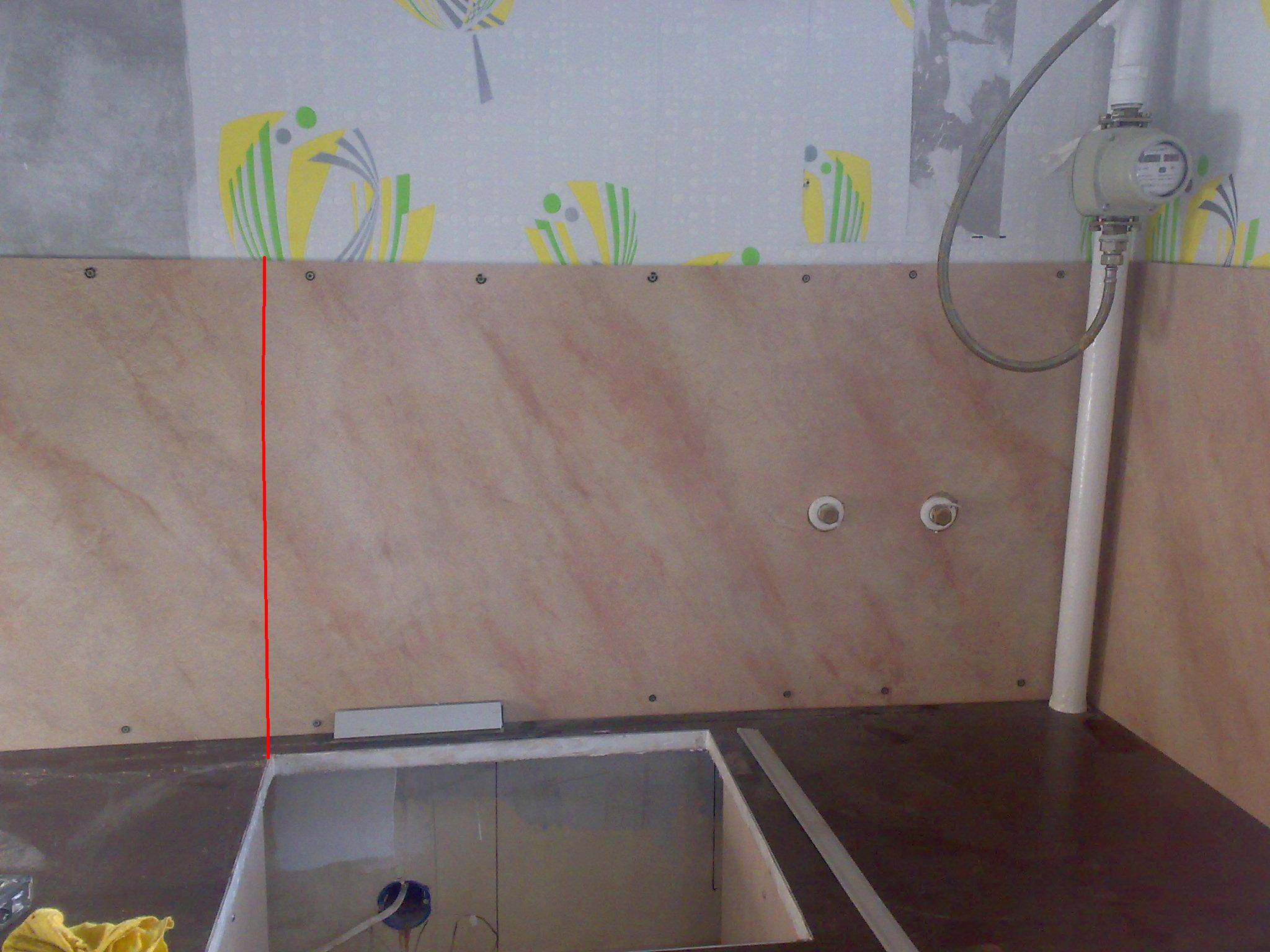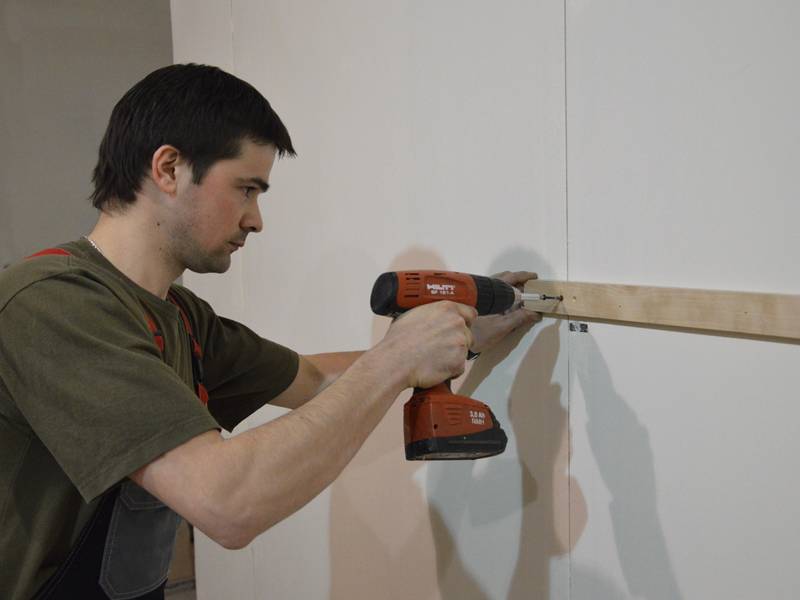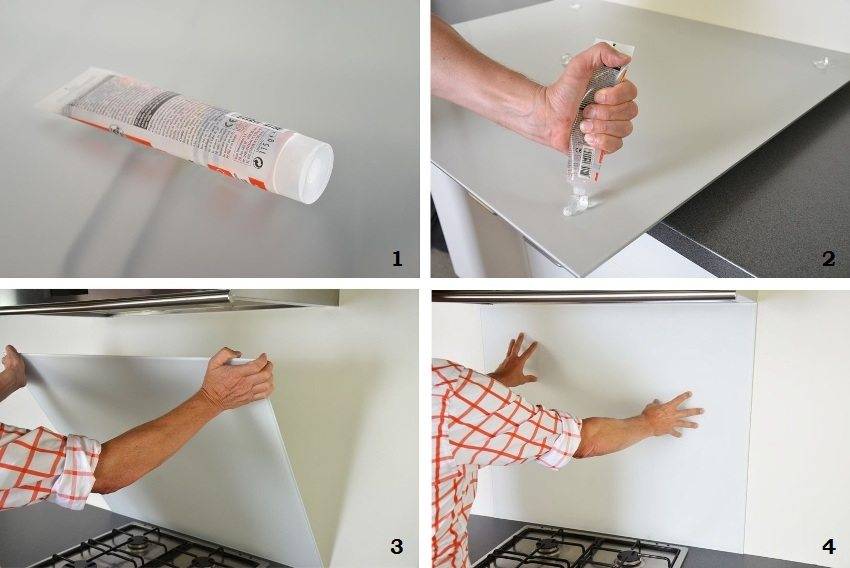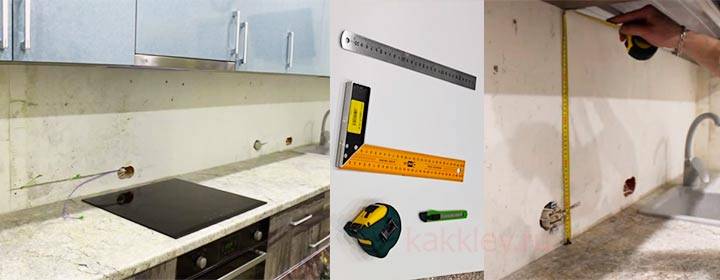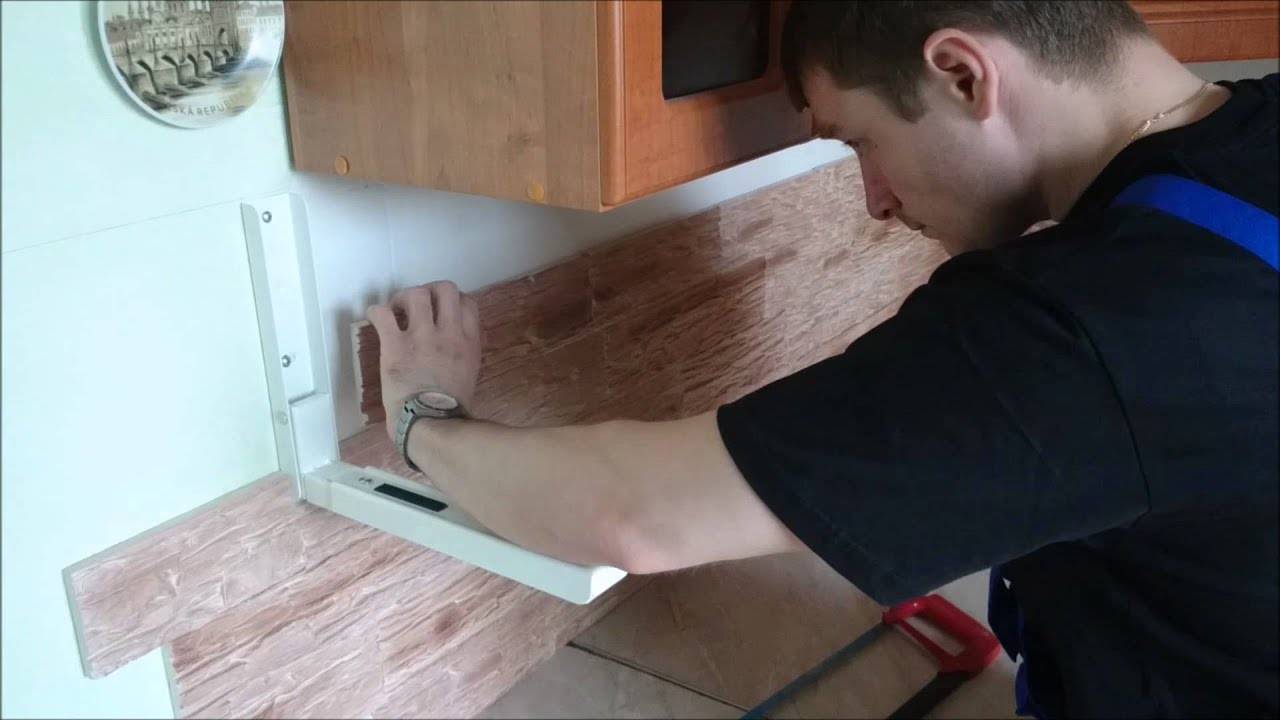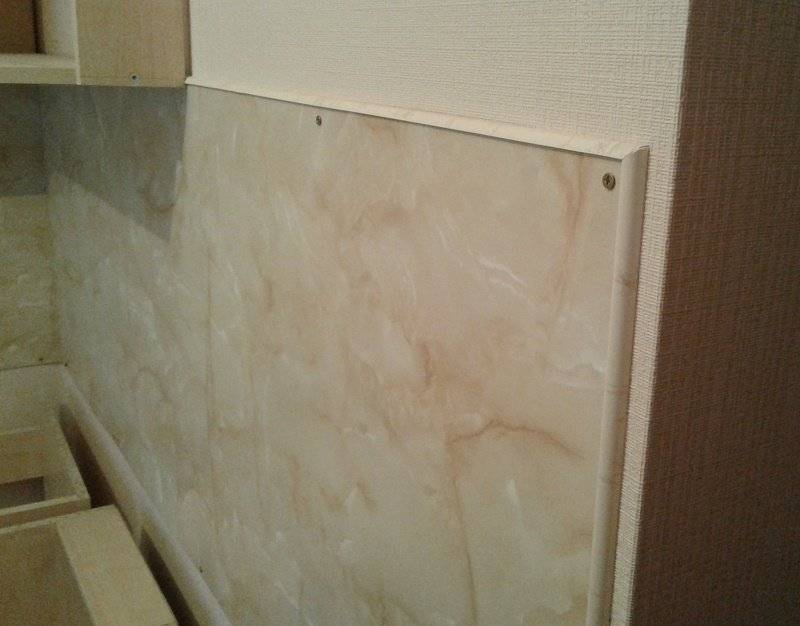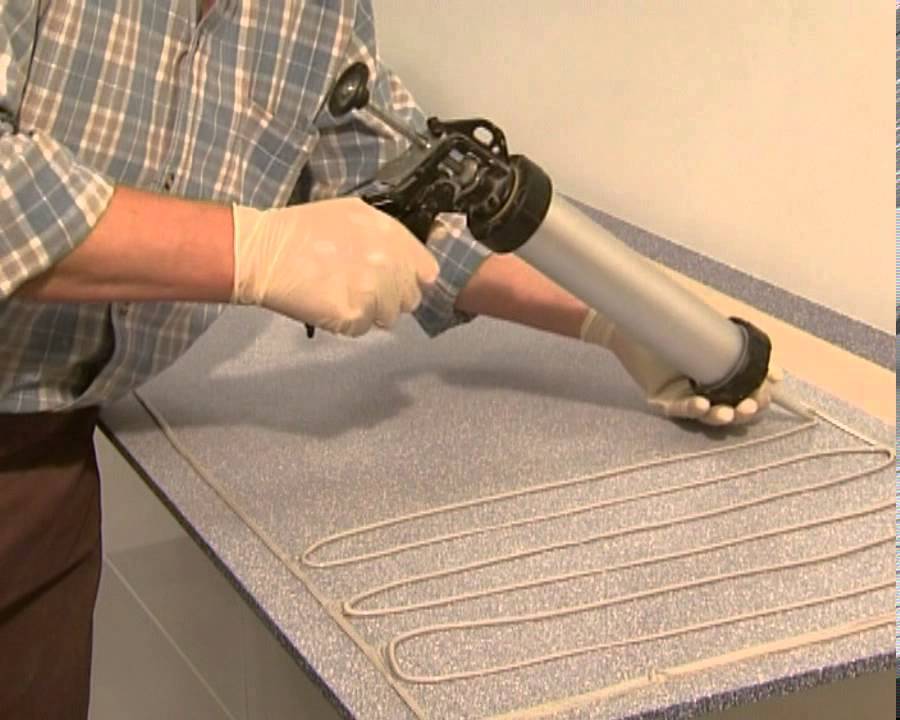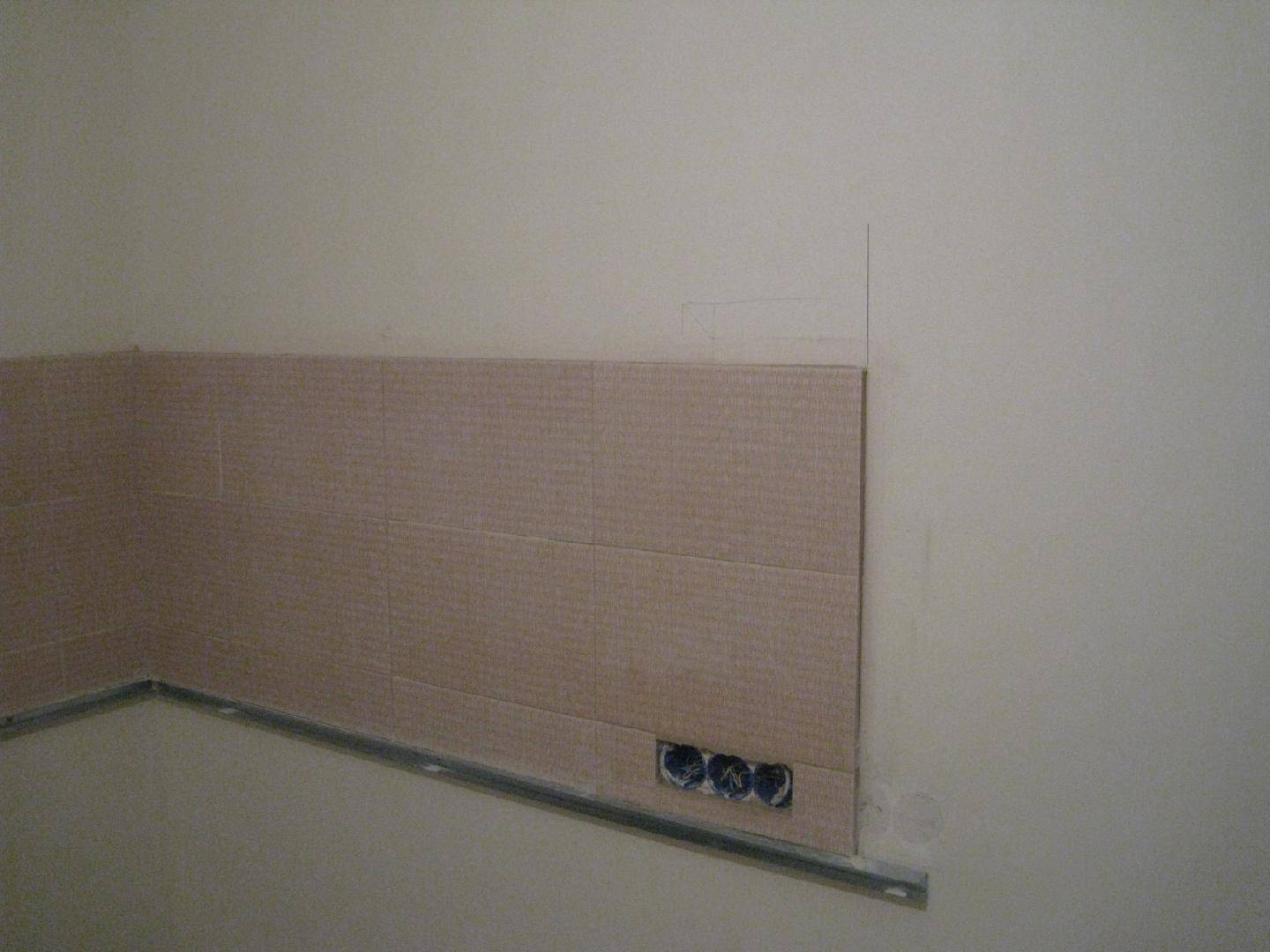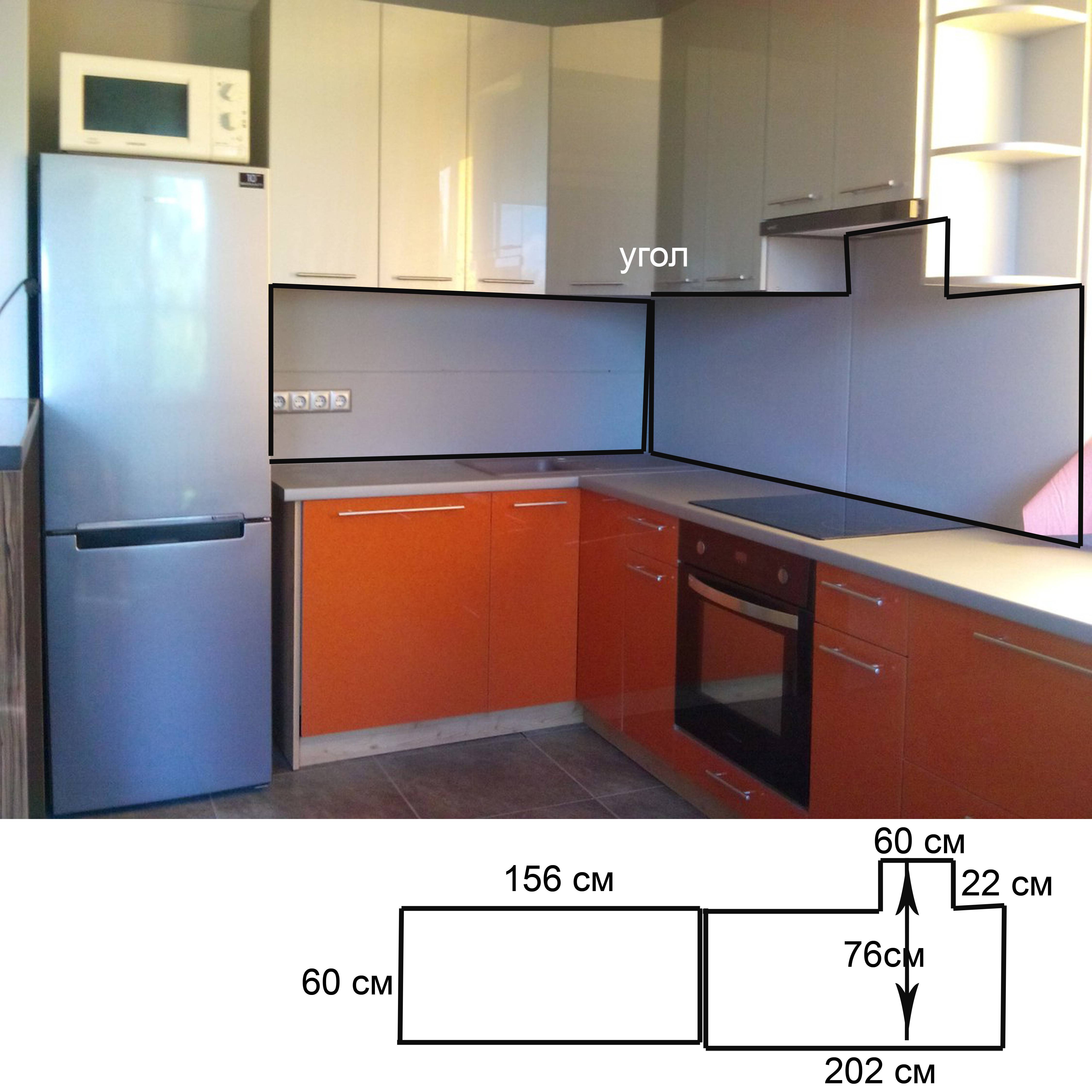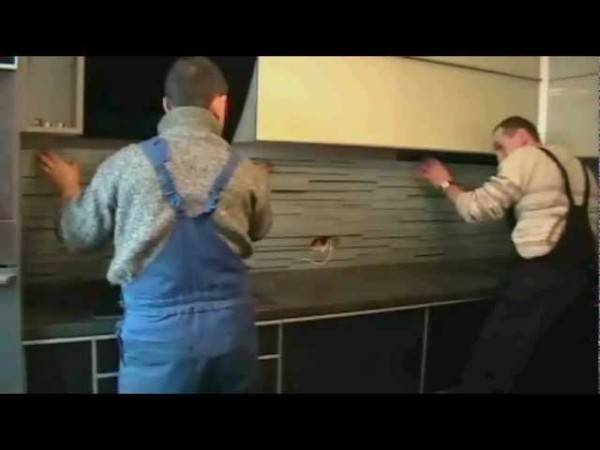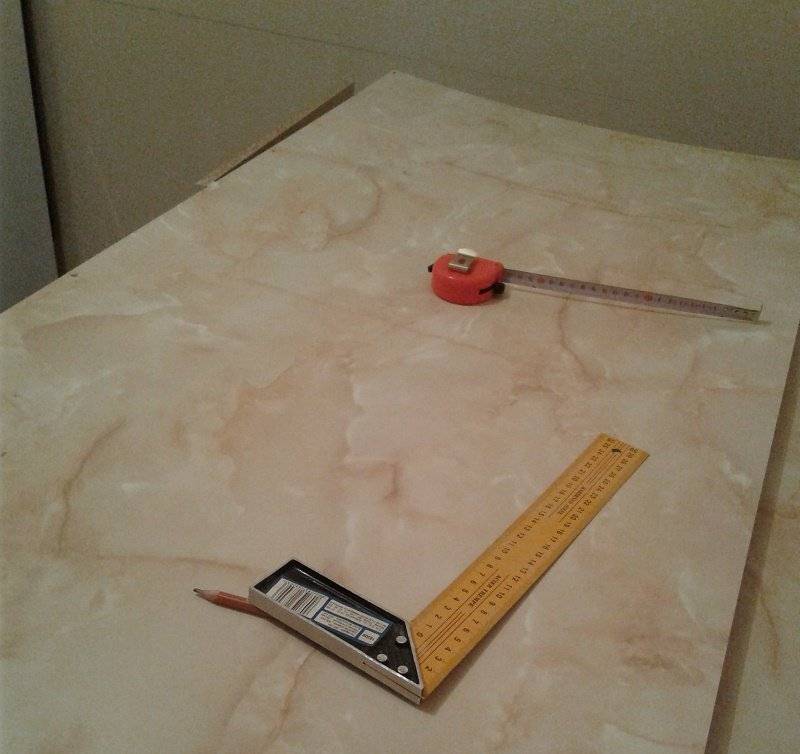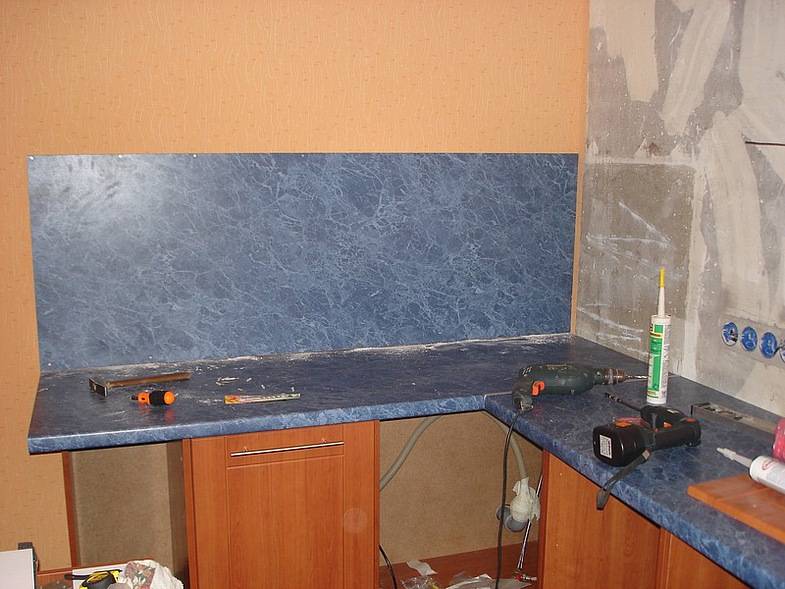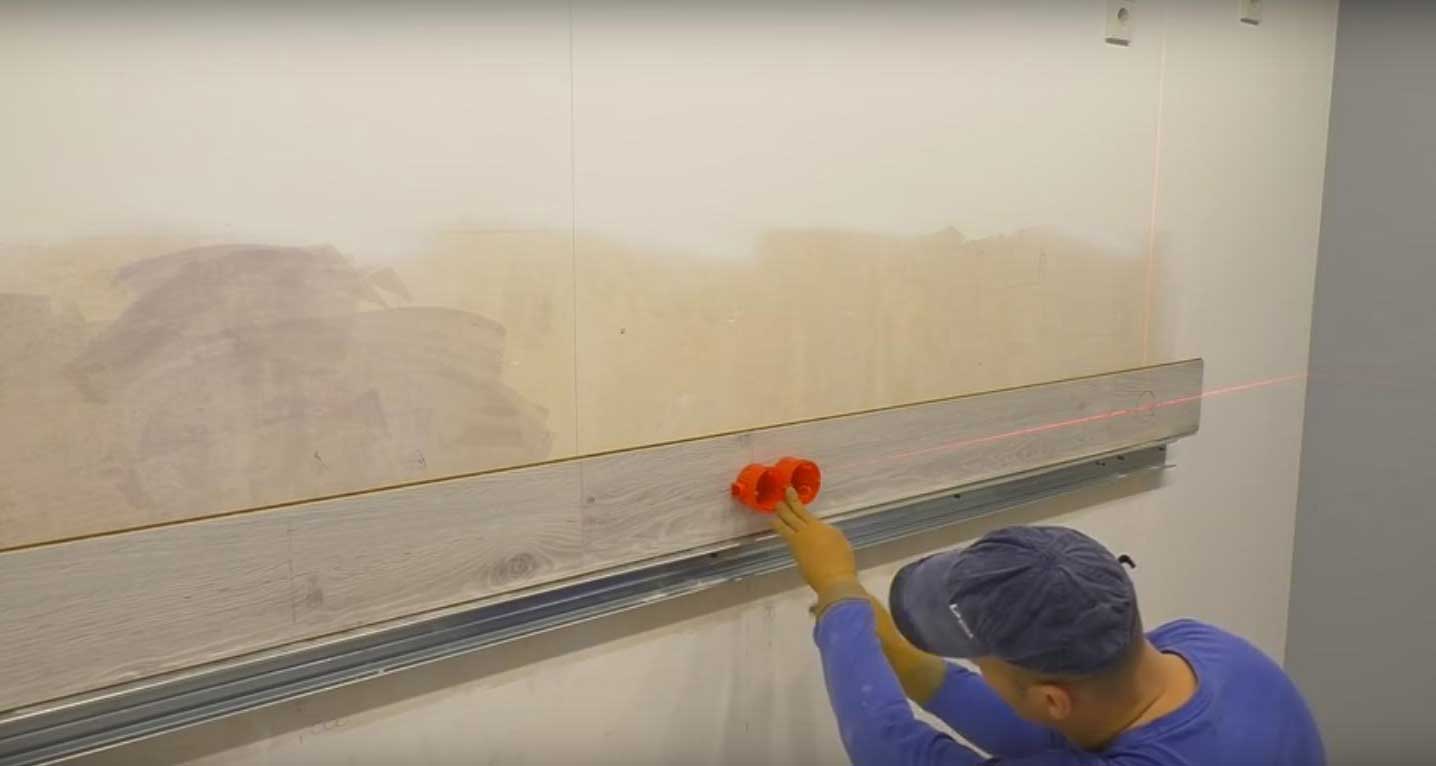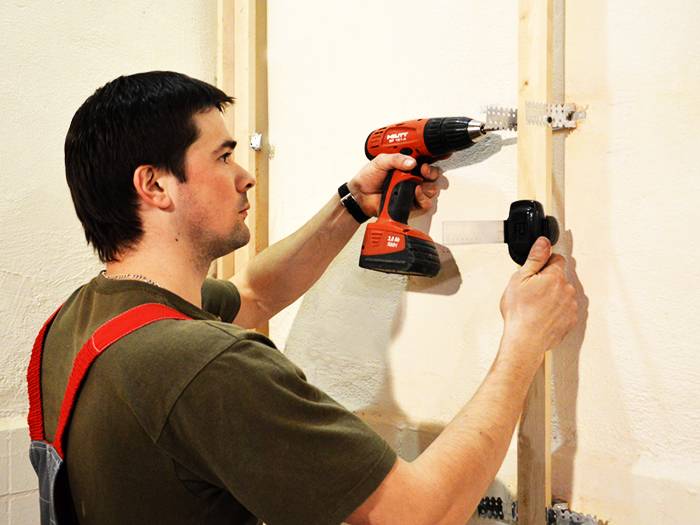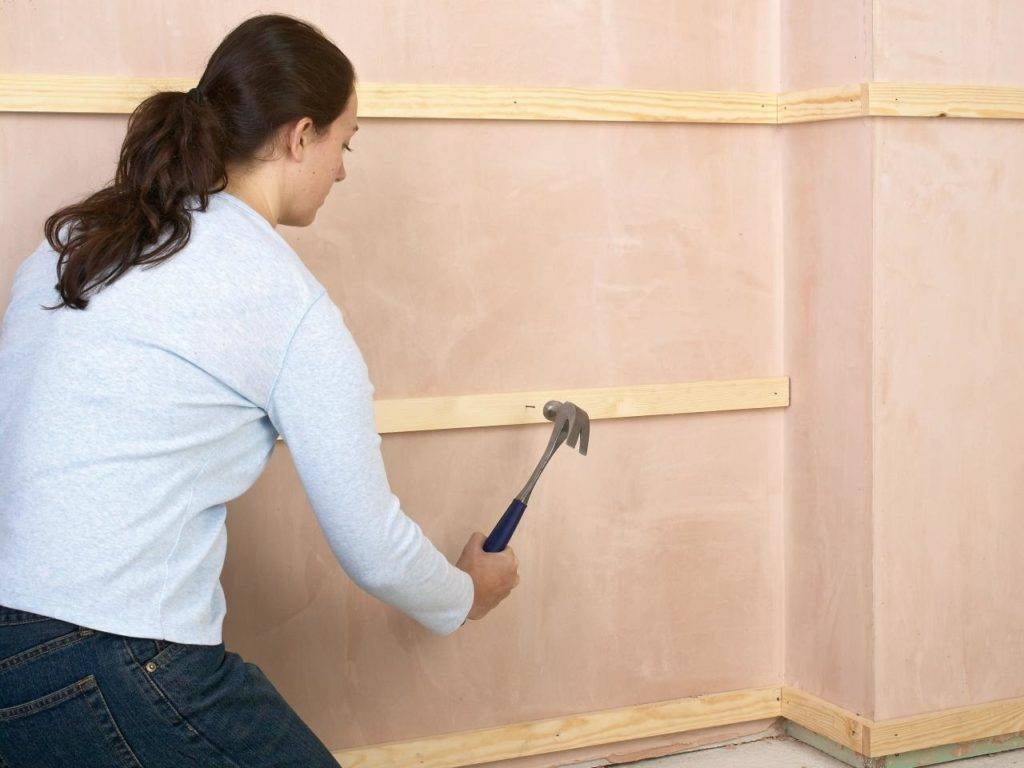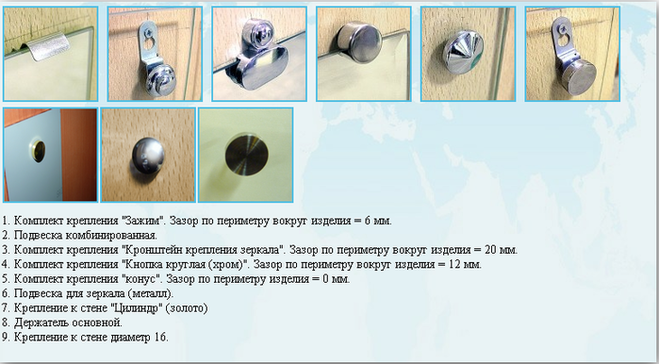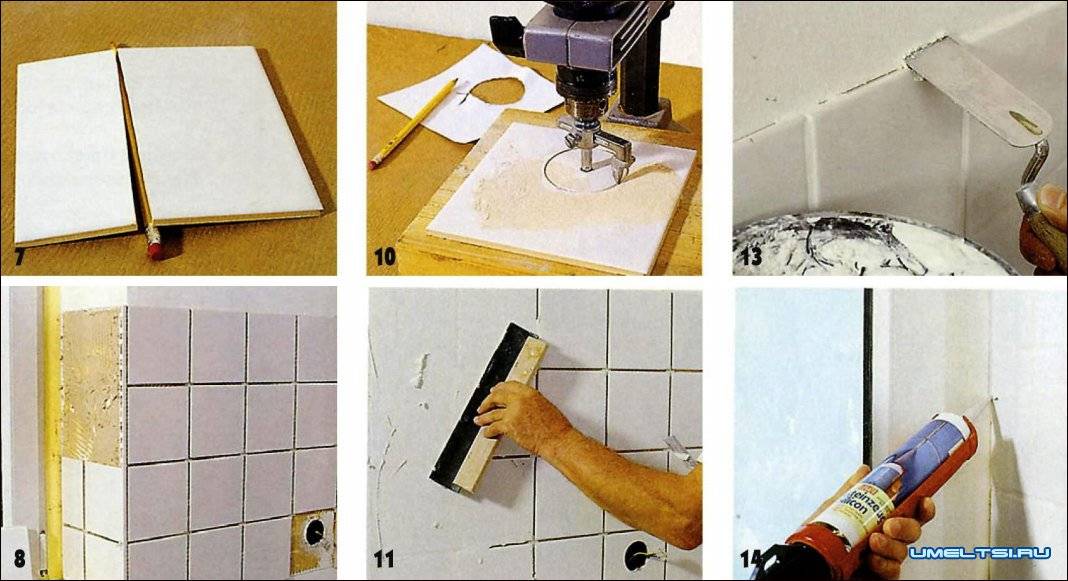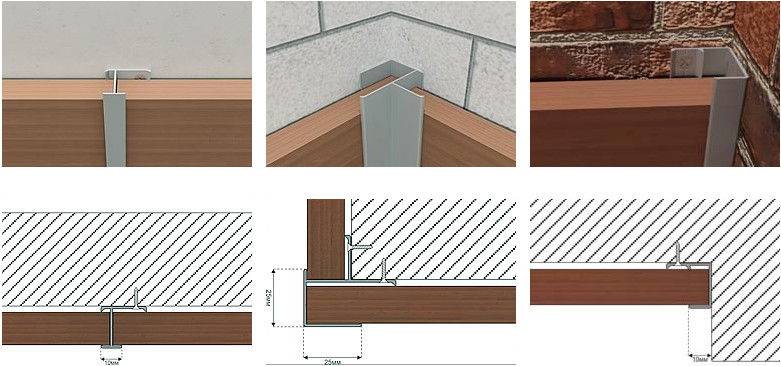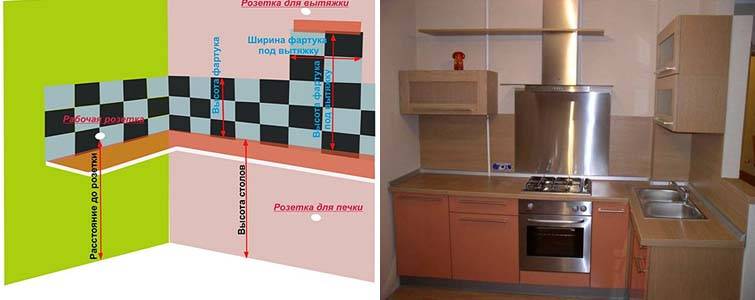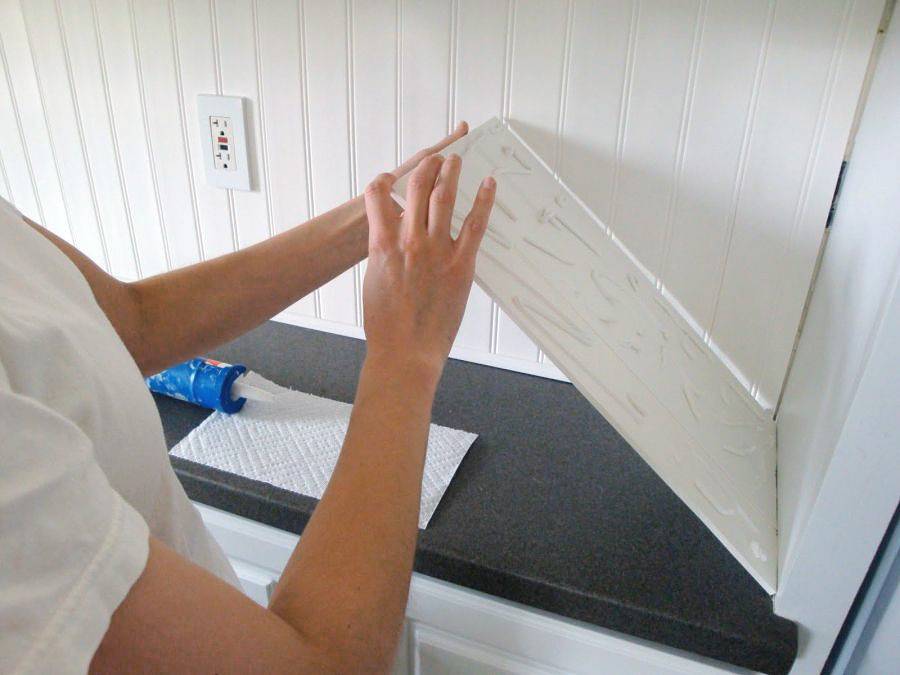What should be an apron
An apron, as an element of the interior, not only decorates the space between kitchen cabinets. It is designed to protect walls from the ingress of liquids, grease, dirt and soot. For the coating to perform its function, it must be made practical, easy to clean, resistant to high temperatures and chemical detergents.
The wall cladding near the work surface should have a pleasant appearance. Nowadays, aprons are made of ceramic tiles, mosaics or glass. For those who want to make repairs for the ages, cladding made of natural stone, metal or brick is suitable.
How to fix a plastic apron in the kitchen with dowels: instructions
Mounting with the mentioned fasteners should not cause any problems. This installation method is best used for printed panels, as the same adhesive may damage the image slightly. During the work, it is not necessary to move the furniture set. Installation should be carried out according to the following plan:
- Make holes for dowels in the wall and apron with a drill or puncher. At this stage, the building level will come in handy, with the help of which it will be possible to perform accurate markings.
- Clean the surface from the formed dust.
- Attach the prepared apron to the wall and fix it with dowels.
- Disguise the hats with furniture caps, the color of which should match the plastic.
The apron installed in this way is easy to dismantle: for this you need to unscrew the dowels and carefully remove the product. In addition, pins (concrete screws) or anchor bolts can be used for fastening.
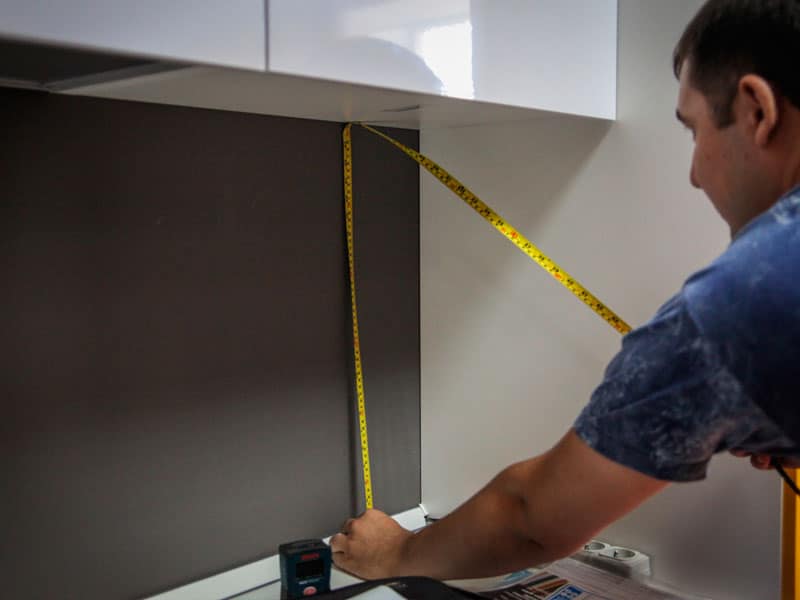
Varieties
In the manufacture of plastic aprons, the following materials are used:
- PVC panels, the standard width of which is 25 cm, and the thickness of 0.8–1.2 cm. They are produced in lengths from 2.6 to 3 m. Their main feature is the presence of special locking fasteners on glossy or matte parts for making seamless joints. Therefore, with proper installation, you can independently make a kitchen apron for the kitchen on the wall in the form of a monolithic surface from individual elements. The main thing is that there are no cracks, otherwise water and debris will get into them. Monophonic, coated or varnished aprons are made of PVC.
- ABS sheets are single-layer plastic materials, decorated with photo printing or drawing. A ready-made kitchen apron made of ABS plastic, as a rule, is produced in dimensions of 200 x 60 x 0.15 cm. Its main advantage is its high resistance to mechanical damage and the absence of deformation during bending. The apron made of sheet plastic is produced in a wide design variety, since high quality images are applied to the surface of the product. In addition, you can order an apron with an original pattern.
- Cast polycarbonate is a refractory plastic material that looks like ordinary glass. The surface is glossy and matte. Kitchen aprons made from this material are sold ready-made. Images imitating tiles, decorative stone, bricks and other materials are applied to the inner polycarbonate coating. In addition, such an apron can be equipped with lighting elements (for example, LEDs) that will illuminate the product.
Taking into account the size of the kitchen wall to be faced, you need to calculate and select the appropriate model.

Wall mounting methods
The method of attachment will largely depend on the severity of the apron or its individual elements. Here are the possible different options:
Glue
One of the most popular are liquid nails.Liquid nails can be used to glue plastic, fiberboard, light MDF panel, ceramic tiles and mosaics, artificial stone, mirror. The main thing is accuracy: the adhesive should not be applied too close to the edge of the panel.
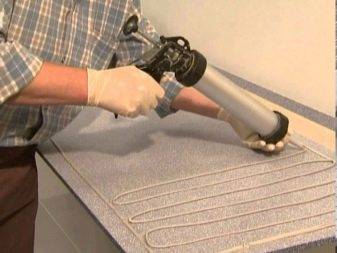
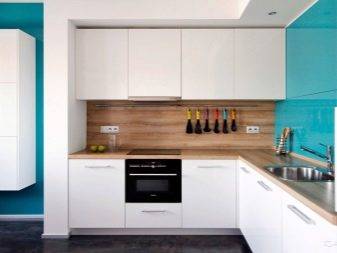
Installation of lathing
This method is used when there is a fear that the panel may fall due to its own gravity. The second reason is that the wall is too uneven. Third, it is much easier to dismantle and replace with another apron using a crate than liquid nails. Both fiberboard and PVC panels can be mounted on the crate. But one of the heaviest materials is the thick MDF board.
Using the crate, panels can be installed in several ways:
- installation of a wooden bar to the wall (with screws or glue), fixing panels with glue to a bar;
- fastening panels to a bar with self-tapping screws or dowels;
- installation of an aluminum profile as a bar, fixing the panels to the profile with self-tapping screws.
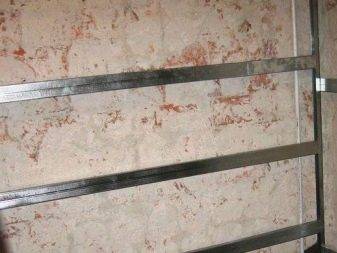
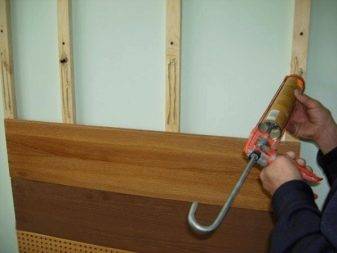
Let's consider step by step in more detail how to install an MDF model with your own hands on self-tapping screws.
- Before starting work, the furniture must be moved aside and the wall must be carefully leveled.
- A frame made of timber and metal profiles is mounted according to the level. The thickness of the timber should be no more than 0.5 cm so that the apron goes behind the countertop.
- The timber is treated with biosecurity.
- The apron is applied to the wall and the markings are made for the holes. Holes are drilled on the MDF plate - blanks for self-tapping screws.
- Only after that the apron is again applied to the wall and tightened with self-tapping screws. They begin to screw in the screws little by little: first in the corners, then closer to the center.
- For aesthetics, caps can be installed on self-tapping screws.
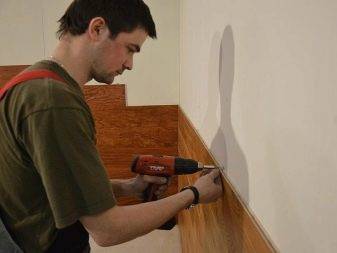
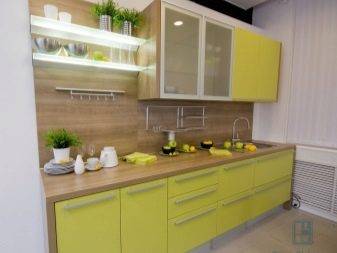
Standard fasteners
Suitable for not too heavy panels. Hinges are glued to their reverse side in a suitable way (available in different versions). Markings are made on the wall where the hooks for these loops will be screwed. Using a drill, holes are drilled into which dowels with hooks are inserted. Then the panel is hung up.
If the hooks are made only along the upper edge, then the panels will hang at different levels from the wall - the gap will be larger at the top, and the bottom will fit snugly against the wall. Not very pretty, but it's easier to mount the apron. Hooks in two rows will make the look more harmonious and attractive.

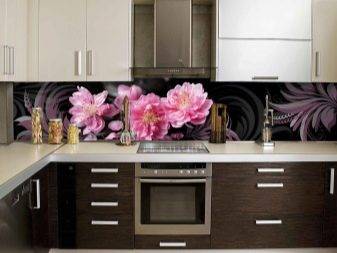
Using furniture glass holders
A great variety of them are sold: in metal, plastic. A large number of holders are needed to attach the entire apron. In addition, it is worth considering that they will not withstand heavy material (thick glass or MDF) and they will be visible after installation. But this is not a problem at all: cute mounts do not attract too much attention. But the mounting method is simple - the holders are fixed on the wall (with glue or screws), and the apron is inserted into the holders.
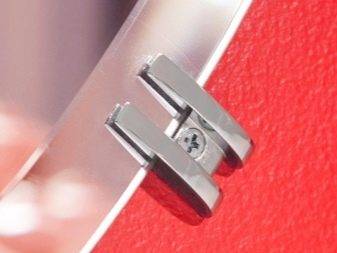
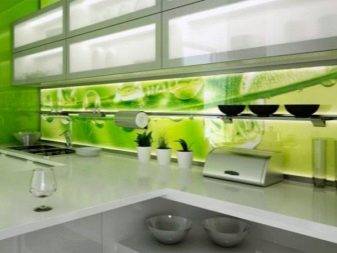
Metal U-profiles or U-profiles
Such profiles are installed on the top and bottom of the apron, after which the wall panel is simply inserted and advanced like a wardrobe door. In this method, the main thing is a clear calculation, otherwise the light canvas will warp, and the heavy one simply will not enter the grooves.
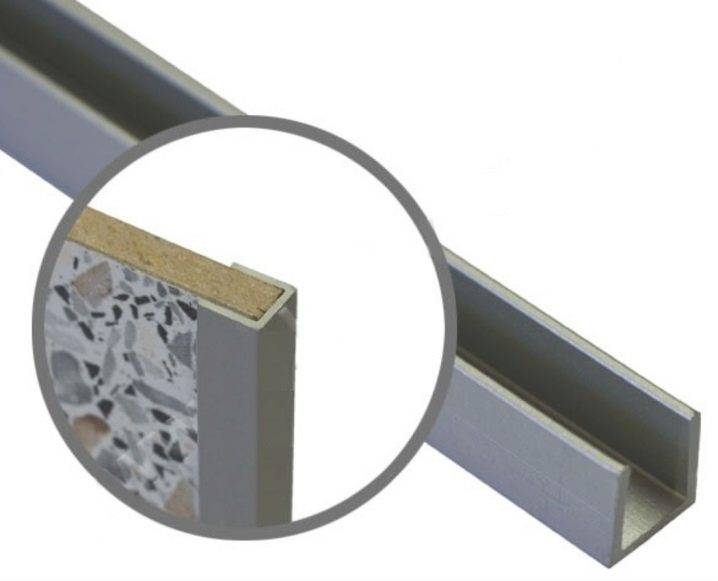
Laying tiles and mosaics on cement mortar
The method is considered outdated, but a properly installed tile will last for more than a decade. This method is chosen mainly because of the cheapness of the cement itself in comparison with the glue.
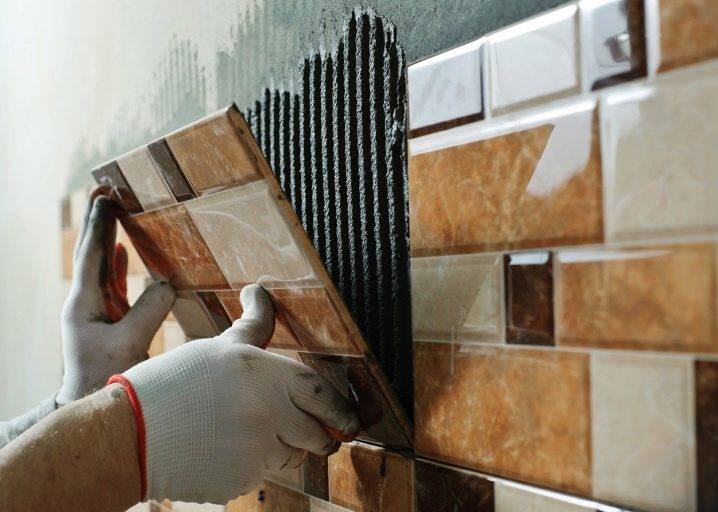
How to install an MDF apron in the kitchen, see the next video.
Apron made of MDF: installation methods, advantages and disadvantages
An apron made of MDF is usually made in the color of furniture or countertops.
As a rule, such aprons are made to match the kitchen furniture or the worktop table top, so an imitation of a single surface is created. No one excludes the possibility of purchasing panels contrasting with the tone of the furniture. With the help of photo printing, MDF panels can be decorated with various patterns and patterns.
The main factor that influences the choice of this option is the low cost of such aprons in comparison with tiles, tempered glass, porcelain stoneware. In terms of its operational properties, MDF is not inferior to natural wood, and even surpasses it in terms of strength. In addition, MDF boards are protected from mold and mildew. Also, the advantages of such an apron in the kitchen include the elementary nature of installation work, the absence of the need to use special tools. You can mount MDF panels on any surface, there is no need to make the walls perfectly flat. In addition, such an apron is easy to replace.
The disadvantages of such aprons include:
- instability to the effects of chemicals and water, which over time will adversely affect the appearance of the apron;
- frequent detachment and sagging of panels;
- MDF is not a fire-resistant material, therefore it can catch fire, while releasing toxic substances.
Installation of MDF panels on the surface is done on "liquid nails" or self-tapping screws. Before that, it is necessary to carry out work on marking the surface. In conclusion, you should install curly skirting boards that will cover the outer and inner corners.
How to glue an apron in a plastic kitchen with your own hands
The installation process itself is not difficult, but it requires accuracy.
At the marking stage, several horizontal measurements should be taken, since the walls are not always perfectly flat.
How to glue the apron correctly?
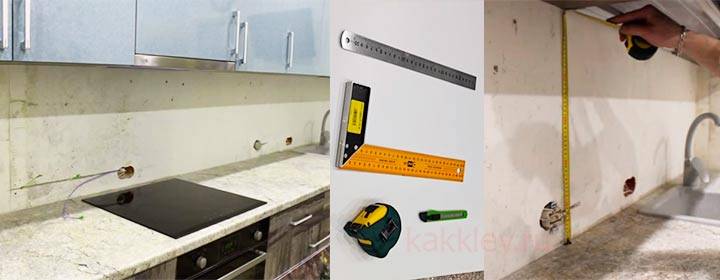
The process consists of several sequential stages:
- Surface preparation. If there are wallpapers on the walls, they should be removed. The wall is cleaned of peeling plaster, various contaminants and covered with a primer. It is better to choose an acrylic primer for rooms with high humidity - it contains antibacterial and antifungal additives.
- Glue application. Liquid nails LIQUID NAILS and any others are applied using a special gun only on a dry, grease-free surface. This should be done not in a continuous layer, but in a dotted manner or in a snake.
- Bonding. The surfaces to be glued are pressed tightly against each other and immediately separated to ensure that there is sufficient adhesive. After 3-5 minutes, the final gluing is carried out, pressing the panel tightly to the wall. Adhesion of the glue occurs almost instantly, however, the greatest adhesion strength is achieved in a day.
VIDEO INSTRUCTION
We glue the MDF apron in the kitchen
This procedure differs little from working with a plastic panel, it also consists of three stages:
- Surface preparation. The wall is cleaned and leveled if necessary. Highly absorbent surfaces are primed.
- Application of liquid nails. The workpiece is tried on in place and cut to size. On the MDF panel, a layer of glue is applied pointwise or with a snake.
- Bonding. The panel is applied to the wall and lightly pressed, after which it is removed, with a technological pause (3-5 minutes). Then the panel is finally glued. For greater reliability, a heavy apron can be supported in several places with slats, after the glue has completely dried, they are removed.
VIDEO INSTRUCTION
Useful Tips
Do not try to glue the plastic panel or MDF apron the first time, as this is not always possible. Place the panel against the wall, then tap and remove lightly.
After pausing for a few minutes, you can proceed to the final gluing. In most cases, it is enough to press the surfaces firmly at the joints once to achieve a quick setting of the adhesive.
The visible parts of the apron edge should be additionally refined with corners for MDF of a suitable color.
Install the apron yourself
While the process of installing a kitchen backsplash is fairly straightforward, there are several challenges that a novice worker can face.First of all, you need to decide on the placement of the cladding and the method of its attachment. Everything else depends on the variety of the kitchen apron itself.
Working with sheet plastic
When installing a plastic apron, it is necessary to determine in which direction the panels will be located. If the plastic sheet is wide enough, it is better to place it horizontally so that there are fewer seams on the apron. Narrow panels should be cut into pieces and mounted vertically.
The plastic cladding is attached to the wall with liquid nails. For greater reliability, self-tapping screws are screwed on the edges of the apron. Sharp plastic cuts are covered with decorative skirting boards or starter strips. The joints should be masked with strips of a suitable color.
Use of chipboard
Particleboard (chipboard) is a material that is often used for cladding the walls of the kitchen work area. The chipboard apron is mounted only on a flat surface with glue. Before installation, the slab is cut into pieces of the desired size. Large and heavy sheets of chipboard should be additionally secured with self-tapping screws with decorative caps.
Ceramic and Mosaic Tile Applications
When tiling walls in a kitchen with ceramic tiles or mosaics, you must first prepare a special adhesive solution. The mixture is applied to the wall with a narrow trowel and spread evenly over its surface. The tile is installed with slight pressure.
The tile is laid evenly and neatly in horizontal rows from bottom to top. When fastening each row, the horizontal is checked using a level. The mosaic should not be installed individually, but in matrices. Each forms a 30x30 cm slab containing several dozen elements. The rest of the installation is similar to tiles.
Glass needs care
Glass aprons are mounted to the wall using support clamps or glue. Supporting fasteners prevent the glass from adhering tightly to countertops and cabinets. A gap forms between the wall and the glass panel. The advantage of such an attachment is that it does not require drilling holes in the glass that would compromise the strength of the structure.
Glue mounting is only possible if the glass backsplash is made of triplex. Since glue is a chemically active substance, it will most likely corrode any simple glass over time. For fixing glass panels made of artistic triplex, a glue-sealant for mirrors is used.
Stone apron originality and practicality
An apron made of monolithic artificial stone is cut in advance to the required dimensions. Its installation should provide for fastening not only with an adhesive solution, but also with anchor connections. To screw them in, it is necessary to make holes in the wall with a depth of about 10 cm. This will allow you to securely fix the massive structure.
Using an uneven trowel, an adhesive mortar is applied to the back surface of the board. With a slight tap of the mallet, the apron is pressed against the wall. After that, proceed to anchoring.
The anchors take their place and twist gently. Do not overtighten the fasteners as this can damage the structure of the stone slab. After tightening the anchors, the holes in the slab can be closed using special overlays.
How to install an apron in the kitchen from MDF
There are several ways to install an MDF apron with your own hands, especially if the kitchen furniture has already been installed.
When installing on a clean wall, follow these tips step by step:
- Clean the wall, eliminate rough irregularities, treat with an antiseptic and a primer.
- Determine the exact location of the apron, align the horizontal lower and upper lines using a building level.
- Apply clearly visible markings to the wall.
- Under the bottom line, screw the mounting plate to the wall, which will be both a support and a reference point.
Use of glue during installation
The simplest is to install the apron using assembly glue. In this case, it is not necessary to drill holes, but dismantling will be laborious. The removed apron cannot be reused.
The glue is applied directly to the MDF sheet around the entire perimeter. The central part is covered with horizontal or vertical stripes every 10-15 cm. The processed apron is applied in the right place and pressed. The approximate drying time of the glue is 14 hours.
Fastening with dowels and self-tapping screws
In order to fix the apron with self-tapping screws, you first need to drill holes on the panel itself at the attachment points. To seal the material in the holes, silicone liners and threaded metal inserts are used to screw in decorative chrome caps.
Then the panel is applied to the wall and marks are applied. Holes are drilled and dowels are installed. At the end, an MDF apron is attached with self-tapping screws. The attachment points are hidden with caps.
Fastening with an aluminum profile
With installed kitchen cabinets, the installation of an apron for the kitchen can be carried out using aluminum profiles, which are prudently equipped with silicone seals to firmly hold the MDF panel.
First, a lower profile is attached to the wall using self-tapping screws, into which parts of the apron are inserted. Then the panel is tilted a little, the upper profile is put on, pressed against the wall and screwed to the cabinets.
The ends of the planks are hidden with decorative overlays. If necessary, a special skirting board is attached directly to the profile.
Precast panel installation
Sometimes the panel is made of several parts, equipped with special grooves for a secure connection to each other. Before installing a prefabricated apron, a crate is assembled on the wall with a step of jumpers corresponding to the size of the constituent elements. To fasten these elements to the bars, kleimers are used - special metal parts that are put on the inner groove of the panel and screwed to the crate.
Choosing an apron: useful tips
Before buying or ordering a product, there are a few things to consider:
- The edges of the apron should go behind the kitchen unit, so you must first take all measurements.
- To prevent water flowing from the countertop from getting under the product, it is recommended to install a border for the joints, the purpose of which is to prevent moisture penetration.
- For small rooms, the best choice would be a white backsplash that matches the overall design of the kitchen. You can choose a light product decorated with a discreet pattern.
- Covering the wall with a small thermal printed apron by the manufacturer is a bad idea as it will not be visible.
Types of decorative coating of MDF panels
MDF is made by pressing wood chips with an adhesive. The resulting slab is subjected to further decorative finishing using various technologies. The result is: laminated, painted, laminated, veneered MDF boards.
The laminated coating is made by processing the panels with PVC foil or melamine paper. Laminated MDF panels withstand various adverse effects without damage. They are used in the manufacture of furniture, including for the manufacture of the facade in the kitchen.
MDF panels are also painted. And then they make furniture for bathrooms or kitchens. However, painted panels have a significant drawback: such a coating does not tolerate temperature and mechanical factors.
Gluing plastic onto a panel is called lamination. Such a panel becomes more moisture-resistant, wear-resistant and temperature-resistant.Due to their practicality, such panels are often used for the manufacture of kitchen aprons and other kitchen elements.
With the help of MDF veneering, the panels acquire the appearance of natural wood.
There is another way to decorate MDF panels. This is the application of various drawings and photographs to the surface using photo printing. Such panels are called skinned. They were originally made of glass. Skinali are very popular and are used to decorate a kitchen apron.
Calculation of the width and height of the apron
The width of the apron depends on the size of the kitchen area. With height, the situation is somewhat more complicated. This parameter is influenced by the following factors:
- the distance between the lower and upper tier of the headset. The height of this gap is most often no more than 112 cm;
- the presence of a domed independent hood - in this place the apron is laid out to a greater height, and if skinals are used, the hood itself should be placed at a lower height;
- design features of the upper cabinets - if the facades are equipped with lifting mechanisms, a low apron with dimensions of 45-55 cm looks great.

What is the difference between chipboard and analogues
It is necessary to distinguish chipboard from fiberboard - fiberboard, which has low mechanical stability, is fragile, easily breaks and is a dense cardboard of various thicknesses. On the one hand, the fiberboard sheet has an even and smooth structure, and on the other - a rough, loose and corrugated surface, with notches applied. Not used as a decorative material.
Chipboard, MDF and HDF boards are similar to each other both in production method and in quality characteristics. However, there are a few differences:
- chipboard structure is less dense than MDF and HDF;
- chipboard boards are more susceptible to moisture than MDF and HDF;
- chipboard slabs are cheaper.
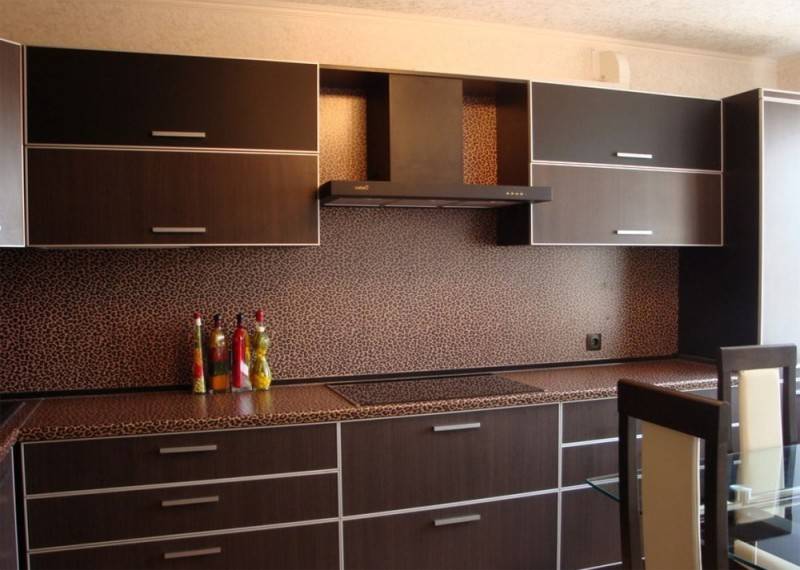 A common disadvantage of products is poor resistance to high temperatures and susceptibility to fire.
A common disadvantage of products is poor resistance to high temperatures and susceptibility to fire.
Preparatory work
The wall is being dismantled. They operate with a hammer drill, spatulas, nail pullers - depending on the interfering elements
It is important to leave it absolutely clean, otherwise you will not be able to fix the wall panel for the kitchen. After dismantling, the wall is washed, impregnated with a primer for future plaster
If the surface requires an impressive repair - a large number of chips, solid pieces falling off, then one embedding is not enough - you will have to completely align the walls, that is, do the entire cycle of plastering work, including laying a reinforcing mesh and setting up beacons.
A beautiful apron made of flowers looks fabulous with light furniture
When the wall is ready - dry, impregnated with an antiseptic - the starting profile is strengthened to it. This is an ordinary wooden lath or aluminum profile for drywall. The guide is placed according to the level, otherwise the whole apron will be skewed. Subsequently, if it interferes with the tight attachment of the headset to the wall, it is removed. Further:
Choice of fasteners
The following types are used for work: liquid nails for plastic, wood or self-tapping screws. The advantages of the first option:
- Ease of operation. A child can also use a liquid nail gun.
- Speed. It is not required to drill holes for self-tapping screws, observe the required level - after fixing, it is possible to immediately align the slab with a liquid composition. Liquid nails dry from 20 to 40 minutes, the total setting time is 24 hours.
- Ease of use. A liquid nail gun is the same tool that installers use when sealing cracks with polymer foam. It remains only to press on the handle and close the hole as unnecessary.
The use of self-tapping screws is not devoid of its own merits. In particular, the home craftsman is confident in their strength and the fastening of the wall panel in the kitchen is reliable. However, the appearance of the MDF will be damaged by micro-chips.Deciding whether liquid nails are better or self-tapping screws can only be experienced.
Beautiful furniture goes well with an apron from nature
Useful Tips
- To make the cladding look neat, close the edge of the kitchen backsplash with special plugs in the form of slats or corners.
- You can close the gaps between the work surface of the worktop and the adjacent wall with decorative skirting boards.
- After fixing all parts of the screen, treat the joints and corners with a transparent sealant.
- Start laying the elements from the corner.
- Sockets and switches are installed after all installation work is completed.
- When taking care of your kitchen apron every day, exclude the use of powders, hard sponges. Abrasive materials will scratch and damage plastic panels.
We advise you to watch the video instruction:
Preparatory work and installation of the apron
Taking measurements
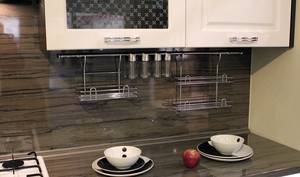 Before installing the apron, of course, it is necessary to measure the area that it should cover. Some people prefer to cover the entire wall with panels from the floor to wall cabinets or behind them. Others only cover the space between the countertop and the cabinets. Decide which option suits you best. And measure the height of the kitchen backsplash.
Before installing the apron, of course, it is necessary to measure the area that it should cover. Some people prefer to cover the entire wall with panels from the floor to wall cabinets or behind them. Others only cover the space between the countertop and the cabinets. Decide which option suits you best. And measure the height of the kitchen backsplash.
Count the number of outlets in the area of the apron. You will need to cut holes for them. Please note that where the hood hangs, the height of the apron will be higher. The length of the panels will be the same as the length of the working area.
If your kitchen set is angular or U-shaped, then it makes sense to close the wall adjacent to the working wall with an apron.
Cooking the surface
After you have decided on the dimensions and purchased the material, you can start preparing the surface. The main thing to do is to level the wall. Perhaps a perfectly flat surface is not needed. But, if there was a tile on the wall and after dismantling it, pieces of mortar remained, this must be removed.
You also need to remove the protruding screws and nails. Replenish pits, cracks, chips. Go over the surface with a putty and, when it dries, apply an antiseptic. This preparation of the wall does not take very long.
For ease of installation, you can install an auxiliary rail as a support for the apron on self-tapping screws. After installing it, the rail is removed.
Installation of an apron made of MDF
Mounting a kitchen apron to the wall can be done in different ways:
- With the help of kleimers. That is, on the seamy side of the panel, "ears" are fixed and simply hung on the wall. It uses the same technology as when hanging cabinets. At the same time, the wall should not have large drops.
- On construction staples with a construction stapler.
- On an aluminum profile. A profile structure is attached along the entire perimeter of the panels and MDF is already inserted into it.
But probably the most common methods are: fastening with self-tapping screws or "liquid" nails. Let's consider them in more detail.
To fix the kitchen apron with self-tapping screws, you need to make a frame of wooden slats on the wall. The slats are fixed to the wall with dowels and aligned in the desired position. Do not forget that they need to be treated with an antiseptic just like the wall. After that, you can fix the MDF apron with self-tapping screws.
To hide the screws, put decorative hats on them to match the panels. Correctly fitted caps are almost invisible on their surface.
Also common is the method of attaching panels to "liquid" nails. In this case, a smoother wall is needed, since the differences will be noticeable. If the apron goes behind the cabinets, then it is necessary to install it first, and then hang the cabinets. If the height is up to the cabinets, then it doesn't matter what you hang first.
So, "liquid" nails are applied to the entire surface of the MDF panel. First along the perimeter, and then in stripes in the center with an interval of 30 cm. After application, press the panel against the wall. This method is even easier than fastening to self-tapping screws.The main thing is to close the joints where moisture can get under the panel. As you can see, installing a kitchen apron is not so difficult.
But some experts say that over time, due to the composition of the "liquid" nails, panels can deform. Therefore, choose your product carefully.
How to care for an MDF apron
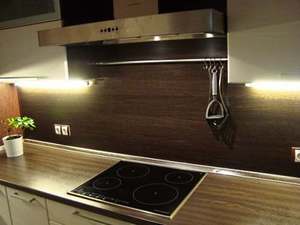 MDF panels are not a capricious material, but there are still nuances in care. It is absolutely impossible to wash an apron made of MDF so that water flows through it. Pay special attention to the edges. The ingress of moisture under the panel is fraught with peeling (if fixed on "liquid" nails) or deformation (if fixed with self-tapping screws). And the surface itself can absorb moisture. Therefore, only a slightly damp cloth.
MDF panels are not a capricious material, but there are still nuances in care. It is absolutely impossible to wash an apron made of MDF so that water flows through it. Pay special attention to the edges. The ingress of moisture under the panel is fraught with peeling (if fixed on "liquid" nails) or deformation (if fixed with self-tapping screws). And the surface itself can absorb moisture. Therefore, only a slightly damp cloth.
Do not use coarse abrasives. Over time, they will wear off the top decorative layer. Also eliminate any acids or alkalis. They are able to delaminate the panel, then only replacement will save.
And lastly, try to place hot household appliances away from the apron. Constant exposure to high temperatures leads to deterioration of the panels.
If you follow the rules of care, your kitchen apron will last you a long time.
Varieties
Today there are a large number of varieties of aprons for the kitchen, made from a variety of materials. They expand the possibilities for renovation, allowing you to bring bold design solutions to life.
PVC panels
PVC panels used to install an apron in the kitchen have the following competitive advantages:
- easy to install;
- affordable for any family;
- they are easy to care for;
- high moisture resistance;
- nice appearance.
Disadvantages:
- the section of the apron located in the immediate vicinity of the slab needs additional protection;
- during operation, scratches and abrasions quickly appear on the surface of the apron.
ABS
Advantages of using an ABS apron:
- a wide variety of colors and patterns;
- low material weight;
- resistance to moisture;
- hygiene.
Disadvantages:
- weak protection against mechanical damage;
- weak fire resistance;
- with prolonged exposure to sunlight, the material begins to fade;
- quickly collapses upon constant contact with aggressive detergents.

Polycarbonate
Polycarbonate is an inexpensive material, thanks to which apartment owners can decorate their kitchens without spending large sums from the family budget. Despite the apparent fragility, polycarbonate is resistant to various types of damage. The polycarbonate surface is easy to clean from dirt, and the water resistance allows you not to worry about the safety of the repair during the operation of the premises.
Whole leaf
Kitchen aprons made of a single sheet of plastic are more practical than their competitors, since they do not have connecting seams. You will have a smooth, uniform surface that is easy to clean. The disadvantages include large dimensions, as well as the need to cut out recesses for various elements of kitchen decor before direct installation.
MDF
Choosing MDF as the main material for the apron, you get:
- material resistant to mechanical damage;
- high protection against high humidity;
- quick and easy installation;
- the material is cheap, which saves money.
Note! The MDF apron is not recommended to be installed behind the stove, as the material begins to deform under the influence of high temperature
Chipboard
Chipboard has a denser material structure, in contrast to panels made of MDF. They are very cheap, but they are afraid of moisture. The material also reacts poorly to exposure to high temperatures, easily igniting upon prolonged contact with fire.

Glass
A glass apron is considered the best choice for any modern kitchen, and its only serious drawback is the high price. The rest of the material has a large number of advantages, expressed in:
- quick installation;
- ease of use;
- beautiful appearance;
- a wide range of possibilities for the interior designer.
Mounting methods
It is not necessary to hire specialists to install the apron. This process is quite simple, so it is quite possible to handle it yourself. There are various ways to mount the apron. The choice of a particular technology and the complexity of the work depends on the specific material.
On reiki
Alternatively, the apron can be fixed to a wooden frame made of slats. The lathing will allow you to ignore even significant irregularities in the walls. For work, you will need wooden planks with a section of 10x40 mm. The slats are mounted every 40 cm. Care must be taken that the frame elements do not protrude forward, and their surface is in the same plane. The apron is attached to the rails with self-tapping screws. As an alternative to the slats, a metal profile can be used. Almost any materials can be attached to the crate - MDF or chipboard boards, plastic sheets and panels, metal options.
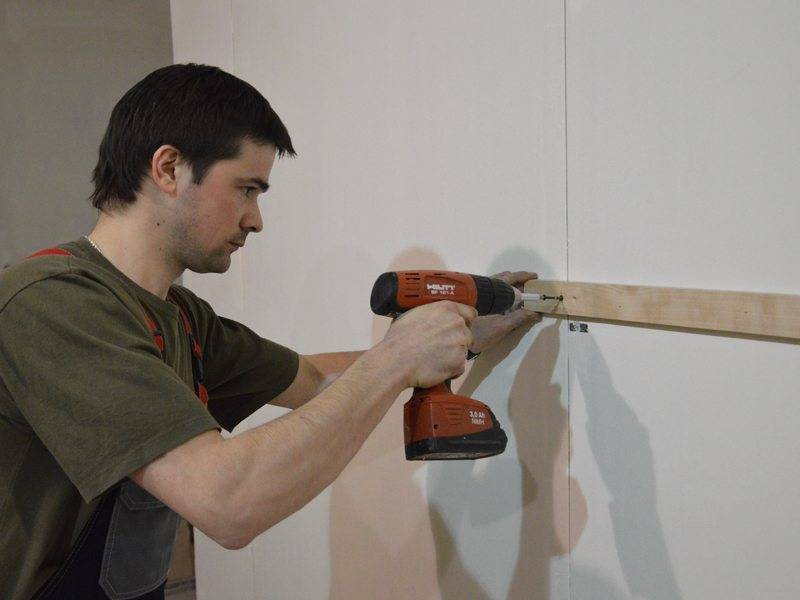
To the kitchen skirting board
The easiest way is to fix the apron with a plinth. The element is built-in between the apron and the work surface, as well as between the upper cabinets and the apron, closes the gaps and turns the structure into a single whole. It prevents moisture and dirt from entering the space between the wall and the worktop. The apron is installed after installing the headset. It is temporarily fixed, after which the skirting boards are installed. Fastening of these elements to adjacent surfaces is carried out using self-tapping screws, which are subsequently closed with decorative plugs.
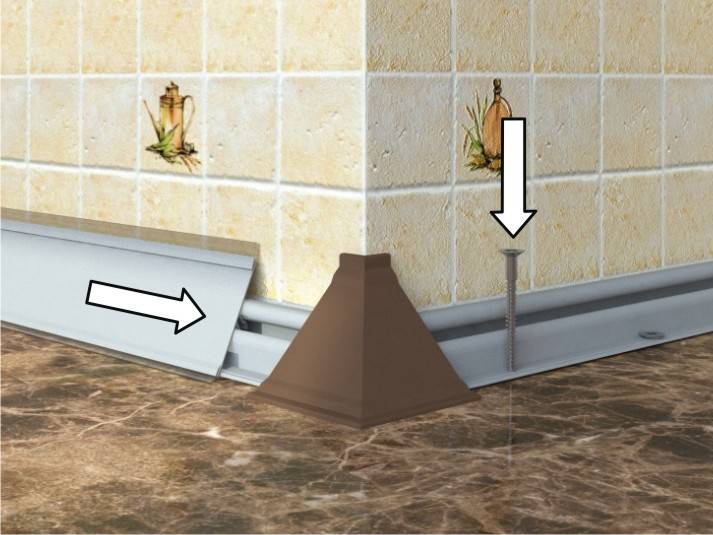
On liquid nails
This method of fastening is suitable provided there is a perfectly flat base. If the old backsplash was made of tiles and the elements of the old coating do not fall off, you can glue the new material directly onto it.
At the preliminary stage, you should prepare the wall. You can dust and strengthen the surface with a primer.
In order to fix the apron, you need to apply liquid nails to it or to the wall, then attach the trim element to the base and hold for a few seconds. It is more convenient to apply the adhesive on a horizontal apron rather than on a wall.

If the panel size is larger than the planned distance between the table top and the upper cabinets, then it must be fixed before installing the headset. For this, liquid nails are distributed on the back of the panel and glued to the wall. To prevent the panel from slipping, you need to make a support from a metal profile or a wooden lath.
If the apron is smaller, the cabinets are mounted first. After gluing the apron, you need to install the skirting boards. They will protect the joints from moisture penetration into the material. If the plinth of the desired color is not available for sale, you can choose a contrasting option.
Work wall options
Plain
Aprons made of MDF are incredibly varied in their color scheme. Monochrome options are produced in a wide range and are suitable for both light and interior black, bright and pastel, matte and glossy. You can choose the panel exactly to match the kitchen set, focus on a contrasting solution, or buy an apron just 1-2 tones lighter / darker than the existing furniture. Read our tips on how to choose an apron for a white kitchen here.
Colored
A solid color solution is not for you? Pay attention to the colored aprons. Panels with imitation of wood, cork, stone, parquet boards, ceramic tiles ... The range is endless
At the same time, it makes no sense to choose a panel according to the principle "dirt is less visible on the dark", because the surface of MDF of any shade is perfectly washed with water.
Photo printing or art drawing
This option is suitable for connoisseurs of non-standard solutions. A real picture will appear in the kitchen area, a canvas that will become a bright accent.You can choose panels with floral ornaments, a panorama of megalopolises, a still life, a picturesque landscape of a mountainous area, or one of hundreds of thousands of other options. Read how to choose an apron for a white kitchen with a black countertop in this article.
For an interior decorated in red and black shades, a Japanese-style panel, options with imitation of animal skins, black and white panels, white panels with large photographs of red berries, etc. will be acceptable.

Panels depicting fruits, a spring meadow, bright butterflies will be appropriate for a kitchen in gentle colors and with floral wallpaper.




